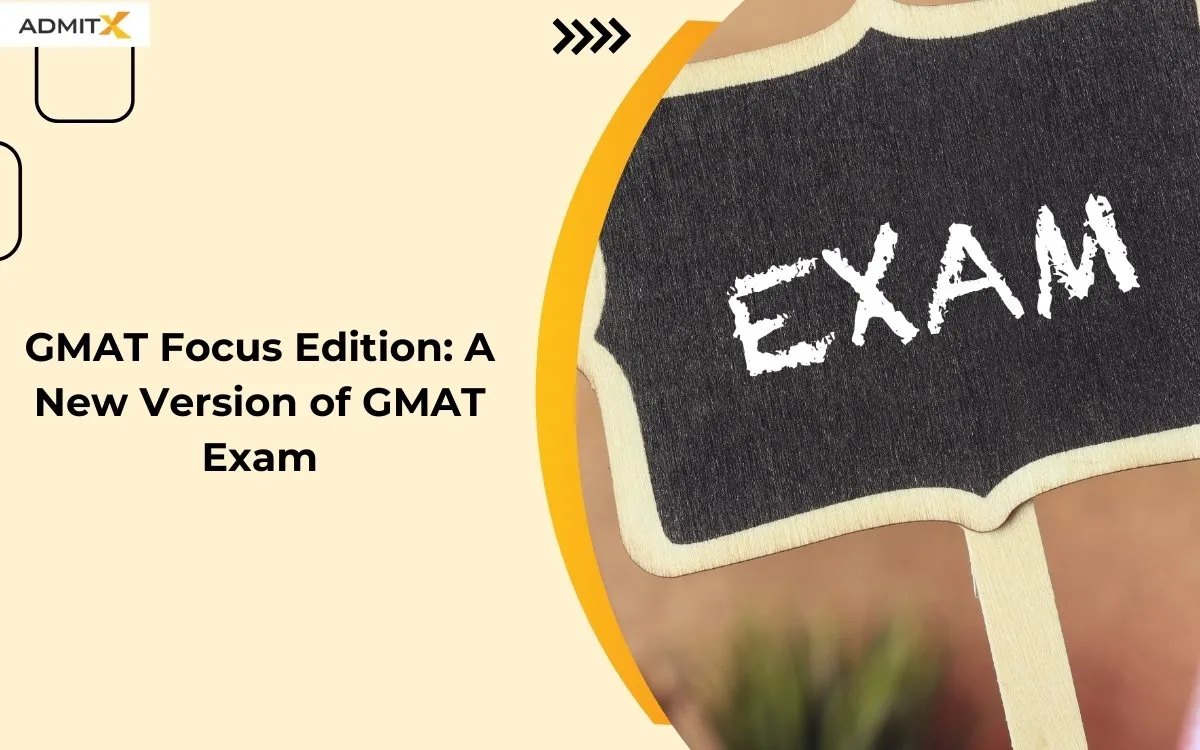
GMAT Focus Edition: A New Version of GMAT Exam
The GMAT Focus Edition is the recently launched version of the GMAT exam. GMAT is the globally renowned standardised test that evaluates the academic preparedness of business school aspirants around the world. This new version focuses more on assessing skills such as decision-making, problem-solving, and data analysis.
This blog will help you understand the key differences between the GMAT Classic and GMAT Focus Edition and how it will benefit the students.
- What is the GMAT Focus Edition?
- GMAT Classic vs GMAT Focus Edition: A Tabulated Comparison
- 5 Changes in GMAT Exam: Updated on 07th Nov 2023
- Change #1: GMAT Exam Structure
- Change #2: Allocation of Time & No. of Questions
- Change #3: More Detailed Insights in GMAT Score Chart
- Change #4: Content Changes
- Change #5: Optimisation of Test Strategy through Answer Review & Edit Feature
- Key Takeaways by AdmitX
- FAQs
What is the GMAT Focus Edition?
- The GMAT Focus is an updated version of the classic or traditional version of GMAT.
- It was launched on 07th November 2023 to serve the demands of the evolving needs of the dynamic business scenarios.
- The classic version of the GMAT (GMAT 10th edition) was officially retired on 31st January 2024.
GMAT Classic vs GMAT Focus Edition: A Tabulated Comparison
The following is the tabulated comparison between the GMAT Focus and GMAT Classics.
| Feature | GMAT Focus Edition | GMAT Classic |
|---|---|---|
| Duration | 2 Hours 25 Minutes | 3 Hours 30 Minutes |
| Total Score | 205-805 | 200-800 |
| Sections | 3 | 4 |
| Structure | Quantitative Reasoning Verbal Reasoning Data Insights | Quantitative Reasoning Verbal Reasoning Integrated Reasoning Analytical Writing Assessment |
| Total Questions | 64 | 80 |
| Analytical Writing (Essay) | Not included | Included |
| Flexibility | Can review and change answers (up to 3 per section) | Not allowed |
| Revised Syllabus | Sentence correction is eliminated | Part of syllabus |
| Order Selection | Test takers can choose which section they want to attempt first | Not allowed |
| Score Report | Score delivery in 3-5 days | Score delivery in 20 days |
5 Changes in GMAT Exam: Updated on 07th Nov 2023
- GMAC has replaced the traditional edition of GMAT (GMAT Classics) with GMAT Focus Edition.
- This has incorporated 5 major changes in the GMAT syllabus, exam pattern, exam structure, duration, flexibility and order of the questions, scoring system, etc.
- We have discussed them in the sections below.
Change #1: GMAT Exam Structure
| GMAT Focus | GMAT Classics |
|---|---|
| Verbal Reasoning | Quantitative Reasoning |
| Quantitative Reasoning | Verbal Reasoning |
| Data Insights | Integrated Reasoning |
| - | Analytical Writing Assessment |
- The major changes that GMAC incorporated are related to its structure.
- There were 4 sections in the GMAT classic.
- In the latest version of the GMAT exam, there are 3 sections.
- Also, the integrated reasoning section is replaced with data insights.
- This was incorporated to eliminate the emphasis on the rote learning approach.
- The data insights section allows a deeper evaluation of data literacy skills required in the modern business environment.
| Section | Relevancy in GMAT Focus Edition |
|---|---|
| Verbal Reasoning & Quantitative Reasoning | Test the higher-order reasoning skills along with critical reasoning and data literacy skills |
| Data Insights | Evaluation of Data Analysis Data Interpretation Relationships between graphics, numbers, and language |
Change #2: Allocation of Time & No. of Questions
Time Duration
- The time duration in which the GMAT exam must be completed is now reduced to 2 hours 25 minutes, which was 3 hours 30 minutes earlier in the older version.
- This is because the new GMAT Focus Edition consists of 3 sections of 45 minutes duration each.
- A 10-minute break is also provided to the candidates in the new exam edition between the 2nd and 3rd sections.
Section-wise Time Allotment
| Classic GMAT | Sections | GMAT Focus Edition |
|---|---|---|
| 65 Minutes | Verbal Reasoning | 45 Minutes |
| 62 Minutes | Quantitative Reasoning | 45 Minutes |
| 30 Minutes | Analytical Writing | Removed |
| 30 Minutes | Integrated Reasoning/Data Insights | 45 Minutes |
| Total Time- 3 Hours 30 Minutes (with breaks) | Total Time- 2 Hours 25 Minutes (with breaks) |
No. of Questions
- The new test is efficient and less time-consuming with the removal of the analytical writing section and shortening of verbal and quant sections.
- The older version of the GMAT consisted of 80 questions, whereas the GMAT Focus Edition now comprises 64 questions.
- However, more emphasis has been placed on improving the quality and experience of the test.
| Classic GMAT | GMAT Focus Edition | |
|---|---|---|
| 36 Questions | Verbal Reasoning | 23 Questions |
| 31 Questions | Quantitative Reasoning | 21 Questions |
| 1 Essay | Analytical Writing | Removed |
| 12 Questions | Integrated Reasoning/Data Insights | 20 Questions |
| Total Questions- 80 | Total Questions- 64 |
Change #3: More Detailed Insights in GMAT Score Chart
- The scoring system of both versions of the GMAT exam contains 61 score levels.
- The scoring range of the GMAT is as follows.
- GMAT Classic: 200-800
- GMAT Focus Edition: 205-805
- Unlike the older version of the GMAT, each section carries its score in the range of 60-90.
- The older version of the GMAT score was based only on verbal reasoning and quantitative reasoning.
- The GMAT Focus Edition provides individual scores for each section, which provides a more detailed evaluation of the candidate’s abilities.
Change #4: Content Changes
The changes incorporated in the GMAT exam content are described below section-wise.
Quantitative Reasoning
- The number of questions has been reduced to 21 from 31.
- Data sufficiency and problem-solving questions have been retained.
- The questions are fewer but more relevant to the problems that are directly applicable to the business world.
- More emphasis on solving practical problems and interpreting quantitative data.
- Questions now aim to check analytical reasoning rather than rote computation methods.
- The section is aligned to evaluate the competency of individuals in solving real-world problems.
Verbal Reasoning
- The number of questions has been reduced to 23 from 36.
- Reading comprehension and critical reasoning questions are retained.
- Sentence correction questions have been eliminated.
- The questions are more focused on evaluating higher-order reasoning skills rather than grammatical skills.
- More emphasis is placed on assessing skills like argument evaluation and critical interpretation.
- Questions are now aligned to check the practical application of verbal reasoning in business scenarios.
Data Insights
- This section has replaced the integrated reasoning.
- The number of questions in the data insights section is 20 questions.
- The section is focused on analysing the skills needed for interpreting the data in real-world scenarios.
- The types of questions under the data insights section are as follows
- Data Sufficiency
- Multi-Source Reasoning
- Table Analysis
- Graphics Interpretation
- Two Parts Analysis
Change #5: Optimisation of Test Strategy through Answer Review & Edit Feature
- The GMAT Focus Edition now allows candidates to review and change the answer, which was not possible in the older version.
- Now, candidates can bookmark and review as many questions as they want.
- Along with this, they are able to change or edit up to a maximum of 3 answers per section within the remaining section time.
Key Takeaways by AdmitX
To conclude, it has to be said that the new version of the GMAT exam (GMAT Focus Edition) is much more relevant than the previous one as it evaluates the candidate comprehensively and holistically.
Unlike the older version, it assesses the candidate’s reasoning abilities, critical thinking, solving practical problems, etc., in the domain of real-world application. With the incorporation of the updated version, the emphasis on evaluating the qualities of rote memorisation and learning is eliminated.
FAQs
How is the GMAT score calculated?
The score of GMAT Focus Edition is calculated by combining the score of each individual section (which is earned in the range of 60-90) through a complex algorithm. These scores are equally weighted across all the sections.
Can we take the GMAT exam from home?
Yes, candidates can appear in the GMAT exam at home (online), depending on their personal preferences and situations. However, they must maintain the test standard by following GMAC’s instructions.
Is the GMAT Focus Edition available now?
Since February 1, 2024, the GMAT Focus Edition has been available globally for evaluating the academic preparedness of aspirants for business management programs.
Do the IIMs accept the GMAT scores?
Currently, only 8 IIMs out of 21 are accepting the GMAT scores for offering admission into some of their business management programs, including MBA.
The IIMs which accept the GMAT scores are located in Ahmedabad, Bangalore, Calcutta, Indore, Kozhikode, Lucknow, Shillong, and Udaipur.
What GMAT score is good?
The GMAT score between 700-730 is generally considered good. However, to become a competitive applicant, you should aim to achieve a score of 730+ on the exam, which is possible with the right strategy and preparation.







